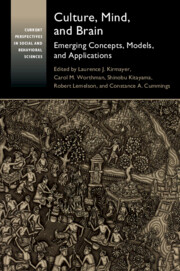Book contents
1 - Introduction
Co-constructing Culture, Mind, and Brain
Published online by Cambridge University Press: 18 September 2020
Summary
In this introductory chapter, we outline some conceptual building blocks for an ecosocial view of the co-construction of mind, brain, and culture. The brain is the organ of culture; mind and experience are processes located in loops of active engagement of brain and body with the social world. This engagement occurs on multiple time scales, from evolution and co-evolutionary adaptation to humanly designed niches, through the cultural history of populations and communities, to individual developmental trajectories, narratives of the self, and moment-to-moment engagements with social contexts. We are born biologically equipped to acquire culture and, across our lifespan, we become attuned to particular social and cultural environments. The niches we inhabit are cooperatively constructed and presented to us as cultural affordances that enable our cognitive capacities, sense of self, adaptive skills, and meaning-making capacity. The rewiring of brain circuits, synaptic plasticity, and underlying changes in gene regulation only make sense in relation to the particular resources, affordances, and adaptive tasks presented to us by specific cultural environments. Answering the question of what makes us human then turns out to involve not just an evolutionary story in deep time, but also cultural and individual stories in historical, developmental, and biographical time.
Keywords
- Type
- Chapter
- Information
- Culture, Mind, and BrainEmerging Concepts, Models, and Applications, pp. 1 - 50Publisher: Cambridge University PressPrint publication year: 2020



